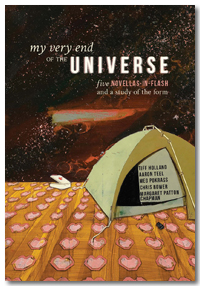My Very End of the Universe: Five Novellas in Flash and a Study of the Form
My Very End of the Universe: Five Novellas in Flash and a Study of the Form
By Chris Bower, Margaret Patton Chapman, Tiff Holland, Meg Pokrass, and Aaron Teel
Rose Metal Press
Paperback, 328 pages
978-0-9887645-8-3
Since its foundation in 2006, Rose Metal Press has established itself as a leading publisher of flash fiction and hybrid-fiction books, chapbooks, and anthologies. Their newest collection, My Very End of the Universe, edited by founders Abigail Beckel and Kathleen Rooney, gathers together five novellas-in-flash along with essays on the craft written by the authors. The result is an anthology that succeeds as “both a gripping, gratifying read and a tool for teaching and learning,” a pedagogical manual for the aspiring writer as well as an entertaining look at a new contemporary genre. The novellas-in-flash include two previous winners of Rose Metal Press’s chapbook contest (Tiff Holland’s “Betty Superman” and Aaron Teel’s “Shampoo Horns”) along with three new stories (Meg Pokrass’ “Here, Where We Live,” Margaret Patton Chapman’s “Bell and Bargain,” and Chris Bower’s “The Family Dogs”). The scope and variety of the stories counterpoise the brevity of the flash form, further emphasizing the genre’s possibilities.
For readers unfamiliar with the novella-in-flash, Beckel and Rooney introduce the collection by providing historical context for what they see is an emerging genre. Noting antecedents in Edgar Allan Poe’s work, Beckel and Rooney argue that there has been a marked increase over the last five years of works that might be termed novellas-in-flash. The editors resist quantifying the genre by word count alone, stating that the genre highly depends on the creator and as a “newish” genre, does not have strict formal conventions.
Nevertheless, the stories share certain characteristics. Most are coming of age narratives that focus on one or two characters that resist easy categorization. Like traditional novellas, these stories have compact narratives that are further complemented by the use of flash. Teel’s “Shampoo Horns,” for example, explores the function of memory through nonlinear narrative fragments, giving the reader glimpses of the moments before and after a tornado ravages a trailer park while blurring the boundary between make-believe and reality. “Time has lost its shape,” according to the narrator: “Who know how long it took him to string me up in that tree? Civilizations could have risen and fell, oceans formed, the universe could have ceased to expand. In the time it takes a cicada to shed its skin, he could have lifted me up by my feet, flung the length of the sheet that hung below me over the thick part of a low-hanging limb, and strung me up by my ankles.” The narrator’s disorientation mimics that of the novella-in-flash, since the short fictions allow us to imagine the action happening before the story begins and after it ends. Teel notes in the accompanying essay, “Memories are finicky and not easily aligned,” and each narrator grapples with how to make sense of their messy world.
 The essays that precede each of the stories provide context for its genesis as well as the authors’ thoughts on the genre. The essays manage to be informative without being didactic, but the decision to place the essays before the stories may encourage some readers to approach them with a critical eye. At times the essays anticipate the story’s major elements without necessarily giving the plot away, and at their best they inspire readers to pay closer attention to the use of language. Some authors reflect on why and how their stories became novellas-in-flash, while others explain the genre’s form metaphorically. Pokrass likens the genre to a crazy quilt, with “no regular color or pattern.”
The essays that precede each of the stories provide context for its genesis as well as the authors’ thoughts on the genre. The essays manage to be informative without being didactic, but the decision to place the essays before the stories may encourage some readers to approach them with a critical eye. At times the essays anticipate the story’s major elements without necessarily giving the plot away, and at their best they inspire readers to pay closer attention to the use of language. Some authors reflect on why and how their stories became novellas-in-flash, while others explain the genre’s form metaphorically. Pokrass likens the genre to a crazy quilt, with “no regular color or pattern.”
Chapman likens the novella-in-flash’s limitations to a map: “Cartography fails us the same way narrative does—the same way language does, of course. It is a useful approximation of something, but its utility is only in its inaccuracies: what it does not show, what it omits and hides in order that we may see what the mapmaker or storyteller thinks necessary.” These are narratives marked by not only textual absences between flashes, but also what is present or missing in the characters’ lives. Bower’s “Family Dogs,” written in two parts, turns on a revelation of forgotten family memories; Betty Superman’s narrator marvels at her sick mother’s fabulist life told with Technicolor imagery. Chapman’s “Bell and Bargain,” a blend of historical fiction and fantasy told with a lyrical voice, features a girl who was born speaking, but is powerless to save her dying mother: “She tried to find words for a gift, words for a blessing, words for a curse. She could not find them. She had once been the baby who spoke, but what good did it do her?” Each of the stories in this collection vibrates between hope and dejection, and what sticks are not the miracles, but human acts told simply and sincerely. This is a collection of new voices—and an enquiry of a new genre—to be read and shared.
